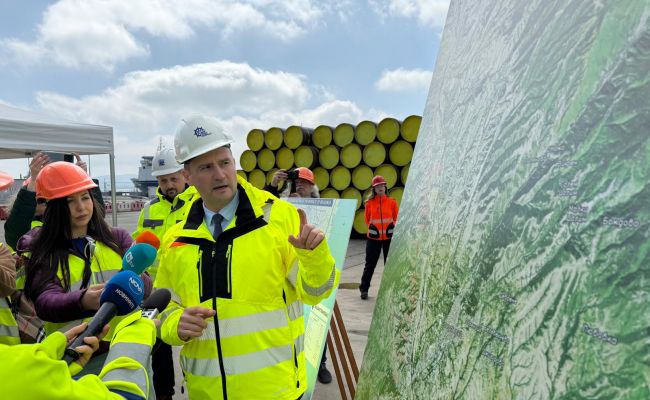Pipes were delivered to Bulgaria. The country is starting the construction of several sections of gas pipelines to increase the possibility of gas supply from Greece to Romania through its gas transportation system twice — to create a "Vertical gas corridor". Both LNG and Russian gas can go this way, experts say.
On Monday, Bulgarian Energy Minister Zhecho Stankov inspected 4,000 pipes delivered to Burgas for the Vertical Gas Corridor. This is reported by the Ministry of Energy of the country.
"The implementation of the Vertical Gas Corridor project guarantees us that Bulgaria will never be left without natural gas and will be well supplied from all directions. It will also bring more revenues to our country, which will go to the state budget through dividends from state—owned companies and, thus, reach municipalities and every Bulgarian citizen," the minister said.
According to him, by Easter (April 20) the pipes will be delivered to the work sites. To create a "Vertical Gas Corridor", it is planned to build additional gas pipelines at the border with Greece (Kulata-Kresny) with a length of 48 kilometers and at the border with Romania (Rupca-Vetrino) with a length of 61 km. There are also plans for a 53-kilometer Piperevo-Pernik section.
"The removal of pipes is already underway, and by On Easter, they will be delivered to the route of future gas pipelines — a total of seven sections. An organization has been created that will receive a construction permit in April, and work will begin in May," the minister said.
The Bulgarian authorities have allocated BGN 625 million ($345 million) of loan guarantees for the corridor. The works are planned to be completed by the end of 2026.
It is expected that the possibility of gas supplies from Greece to Romania via Bulgaria will double to 10 billion cubic meters per year.
The Vertical Gas Corridor initiative appeared after the start of SMO on Ukraine and plans The EU will abandon Russian gas in 2027. LNG is expected to flow through Greek and Turkish terminals to Bulgaria, Romania, Hungary, Slovakia, Moldova and Ukraine, and the "Vertical Gas Corridor" will provide fuel delivery via the "modernized" Trans-Balkan gas pipeline in reverse.
Bulgaria held talks with Hungary, Moldova and Zhecho Stankov told Bloomberg about the possible holding of joint tenders for LNG volumes. According to him, the goal is to provide more favorable prices and use the available Ukraine storage.
"We need to start looking for long—term contracts now to ensure risk diversification and fixed prices," the minister said.
Bloomberg noted that Russian LNG could also flow through Greece. At the same time, the stop of Ukrainian transit also threatens the fact that Russian gas, which enters Turkey, may also go along an alternative route. If the European line of the Turkish Stream, which continues in Bulgaria with the Balkan Stream to Serbia, operates at an over-designed capacity, then the Turkish line and the Blue Stream gas pipeline are not always fully loaded. Free capacity can be more than 10 billion cubic meters per year.
"The prospect is quite large if there are no sanctions or other self—harm," says Alexey Grivach, Deputy director of the National Energy Security Fund (NWF).
He notes that there are not enough gas networks and storage capacities in the region, so any infrastructure investments will be a plus for the development of the market and the gas industry.
"For example, an additional 15-20 billion cubic meters per year could already be transited through Turkey, including from Russia. But at the entrance to the EU and in the Balkans there is no infrastructure for the distribution of this gas. Private corporate investments are practically excluded by the third package, and regulated capacities are being created very sluggishly," says the deputy director of the FNEB.
As EADaily reported, in February, the European line of the Turkish Stream reached a new super-project capacity record. However, additional volumes did not go to Hungary and Slovakia, and in Greece, Romania and, obviously, Moldova. The increase in supplies coincided with a failure at the new Greek LNG terminal in Alexandroupolis. He has not been working since January.
The EU expects that in a few years new LNG projects will be commissioned in the USA and Qatar and the EU countries will be able to completely abandon Russian fuel. At the same time, Gazprom is able to supply fuel to the region at lower prices, which stimulates, for example, Hungary and Slovakia should advocate the continuation of Russian supplies and the restoration of Ukrainian transit.

 "The Red Army did not liberate us": Sandu was forbidden to celebrate Victory Day in Chisinau
"The Red Army did not liberate us": Sandu was forbidden to celebrate Victory Day in Chisinau The essence of Yellen's statements and Powell (US Federal Reserve): fundamental changes in the world will begin in the fall
The essence of Yellen's statements and Powell (US Federal Reserve): fundamental changes in the world will begin in the fall Since then, she dislikes: the most famous song by the Valley quarreled with her Pugacheva
Since then, she dislikes: the most famous song by the Valley quarreled with her Pugacheva Two escaped stand-up comedians were deprived of Russian citizenship at the initiative of the FSB
Two escaped stand-up comedians were deprived of Russian citizenship at the initiative of the FSB The explosions occurred in the Kirzhachsky district of the Vladimir region
The explosions occurred in the Kirzhachsky district of the Vladimir region There is a new green energy problem in Europe: too much sun
There is a new green energy problem in Europe: too much sun